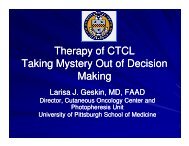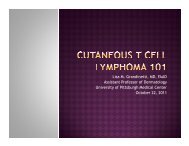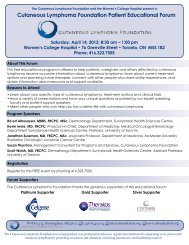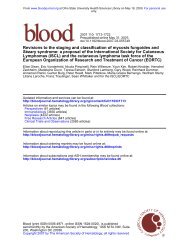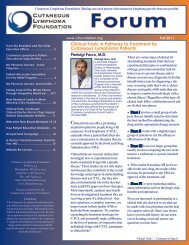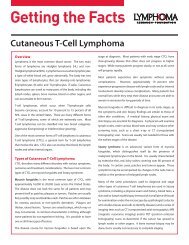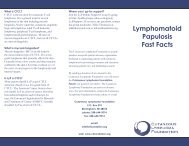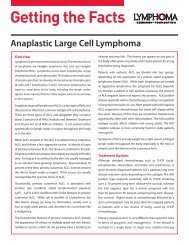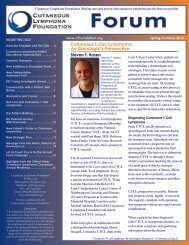Download PDF - Cutaneous Lymphoma Foundation
Download PDF - Cutaneous Lymphoma Foundation
Download PDF - Cutaneous Lymphoma Foundation
You also want an ePaper? Increase the reach of your titles
YUMPU automatically turns print PDFs into web optimized ePapers that Google loves.
Forum, Spring 2008<br />
and has a good chance of succumbing<br />
to the disease within the next 2-3 years<br />
should be considered for an allo-SCT at<br />
this time.<br />
At our center we have found that<br />
total body skin electron beam radiation,<br />
given just prior to the allo-transplant,<br />
decreases tumor burden and may have<br />
immunosuppressive effects on the<br />
GVHD. Electron beam treatment<br />
takes 8-9 weeks with a rest period. It<br />
is followed by 2-3 weeks of in patient<br />
chemotherapy, then the transplant.<br />
After the patient’s counts recover,<br />
they are transferred to outpatient and<br />
make daily clinic visits for the next 100<br />
days, until the risk of acute GVHD<br />
is past. Immunosuppressive therapy<br />
or photopheresis is given to prevent<br />
GVHD. Drugs to prevent viral, fungal,<br />
and bacterial infections are administered<br />
intravenously. Around the time of the<br />
transplant and following it the patient<br />
is at risk for sepsis from their lines and<br />
poor immune systems. They often are<br />
kept in isolation and wear masks. CTCL<br />
may come right back after the SCT. In<br />
this case, donor lymphocyte infusions are<br />
used to supplement the transplant. SCT<br />
have a graft vs tumor effect if the disease<br />
relapses early, before the graft has fully<br />
taken. It is also possible to wind up with<br />
both GVHD and recurrent MF after<br />
transplant, which is a difficult situation<br />
but may respond to photopheresis or<br />
denileukin diftitox.<br />
In summary, transplantation is<br />
the most extreme option for treating<br />
CTCL patients but does offer the<br />
chance of cure. It is safer if done at a<br />
center with experience in CTCL and<br />
in transplantation where the mortality<br />
rate is 10-20% or better. Newer drugs for<br />
treatment of CTCL are being developed<br />
as are better ways to treat and prevent<br />
CTCL. Therefore, patients who get<br />
transplanted have often tried other<br />
treatment options first and are willing to<br />
take the risk of having complications of<br />
GVHD, relapsed disease, infections and<br />
even death. ✹<br />
“NCCN” continued<br />
from front page<br />
not only for<br />
clinicians<br />
and patients,<br />
but also for<br />
medicare and<br />
other health<br />
insurance<br />
providers.<br />
Medicare<br />
and<br />
insurance<br />
carriers<br />
refer to the<br />
NCCN practice<br />
guidelines<br />
for approval and<br />
reimbursement of cancer<br />
UCSF Helen<br />
Diller Family<br />
Comprehensive<br />
Cancer Center<br />
treatments. Thus, the clinicians<br />
who follow the NCCN guidelines<br />
will increase the chance of receiving<br />
authorization and reimbursement for<br />
treatments in the care of our patients<br />
with MF/SS. The MF/SS guidelines<br />
will be updated as new treatments and<br />
scientific evidence are available that<br />
justify incorporating the information in<br />
clinical practice.<br />
The next skin topic that will be<br />
Fred Hutchinson<br />
Cancer Research Center/<br />
Seattle Cancer Care Alliance<br />
Stanford Comprehensive<br />
Cancer Center<br />
City of Hope<br />
Huntsman Cancer Institute<br />
at the University of Utah<br />
UNMC Eppley Cancer Center at<br />
the Nebraska Medical Center<br />
NCCN Member Institutions<br />
The University of Texas<br />
MD Anderson Cancer Center<br />
addressed<br />
by the NCCN NHL panel is to<br />
develop a clinical practice guideline for<br />
primary cutaneous B-cell lymphomas.<br />
Practice guidelines for other cutaneous<br />
T-cell lymphomas will follow in the<br />
coming years including the CD30+<br />
lymphoproliferative disorders. Please<br />
Robert H. Lurie<br />
Comprehensive<br />
Cancer Center of<br />
Northwestern U<br />
Siteman Cancer Center at Barnes-Jewish<br />
Hospital and Washington U School of Medicine<br />
St. Jude Children’s Research Hospital/<br />
U of Tennessee Cancer Institute<br />
U of Michigan<br />
Comprehensive<br />
Cancer Center<br />
Archur G. James Cancer Hospital & Richard J<br />
Solove Research Institute at the Ohio State U<br />
Vanderbilt-Ingram<br />
Cancer Center<br />
U of Alabama<br />
at Birmingham<br />
Comprehensive<br />
Cancer Center<br />
Roswell Park<br />
Cancer Institute<br />
Memorial Sloan-<br />
Kettering Cancer<br />
Center<br />
Fox Chase Cancer Center<br />
The Sidney Kimmel Comprehensive<br />
Cancer Center at Johns Hopkins<br />
Duke Comprehensive<br />
Cancer Center<br />
H. Lee Moffitt Cancer Center<br />
& Research Institute<br />
Dana-Farber/<br />
Brigham and<br />
Women’s<br />
Cancer Center<br />
Massachusetts<br />
General Hospital<br />
Cancer Center<br />
visit the official NCCN website at “nccn.<br />
org” for more information about NCCN<br />
and its resources and activities. For MF/<br />
SS practice guidelines, please go to the<br />
“NCCN Clinical Practice Guidelines,”<br />
then click on “Non-Hodgkin’s<br />
<strong>Lymphoma</strong>s.” ✹<br />
7



